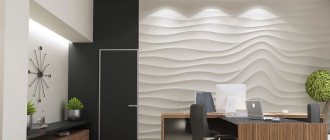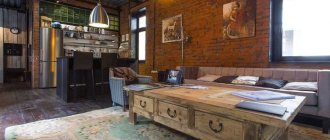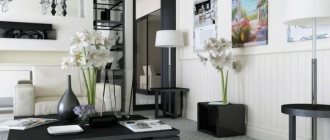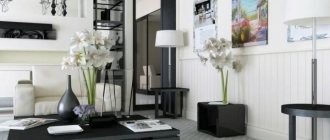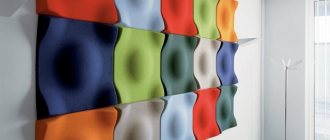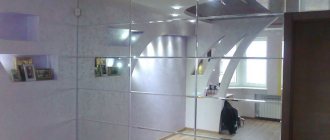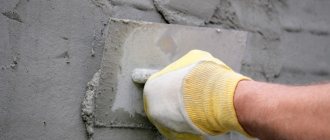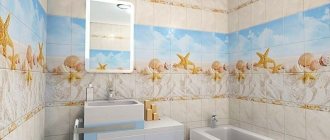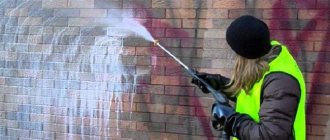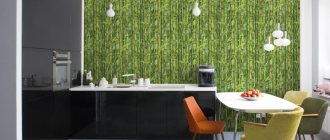Decorative panels are not just a trendy technique for transforming the interior, but also a convenient and practical solution that will help you create a beautiful interior decoration without any problems. Especially if you use 3D panels.
Various variations of design and material help to use it in rooms of any shape, size and purpose - kitchen, bathroom, bedroom.
Types of wall panels
Panels for decorating your home can be selected to suit every taste. Their main difference is the material from which they were made. On this basis they are divided into artificial, natural and combined wall panels. The material can be selected based on your goals and needs.
Natural material panels are made from veneer, solid wood, glass, metal such as aluminum and gypsum. There are also stone panels. They look very beautiful and expensive in the interior.
Artificial panels are made of plastic, PVC (polyvinyl chloride) and PU (polyurethane). They conquer with affordable prices.
By combined we mean wall panels that are made of chipboard (chipboard), laminated chipboard (laminated chipboard) and MDF (medium density fiberboard)
First, let's get acquainted with natural and environmentally friendly materials, and then move on to artificial and combined ones.
Technical characteristics and purpose
The popularity of finishing with PVC panels is due to their technical properties:
- Operating temperature range from -50 to +60°C.
- Resistance to ultraviolet irradiation.
- High hygroscopicity. The material does not absorb water.
- Relatively high fire safety. The flammability is significantly lower than that of wood and other organic materials.
- Easy to install. Even without resorting to the services of professionals, you can quickly and beautifully decorate the room.
- The surface is easy to clean.
- Durability sufficient for interior decoration.
- Improves the heat and sound insulation qualities of the room.
It is worth noting some disadvantages of this material:
- The white surface in the sun becomes yellowish over time.
- Impact resistance is inferior to a number of materials. You should always pay attention to the manufacturer. Not everyone produces PVC wall panels with good strength characteristics.
- Some consumers note that an unpleasant odor persists immediately after repairs. But after a short period of time it completely disappears.
Manufacturers produce mainly products intended for finishing ceilings and walls:
- The requirements for the strength of ceiling panels are low, so such products have a small number of stiffeners. But the requirements for joint density are very high. When finishing the ceiling, it is extremely undesirable for the joints between the sheets to be noticeable. The thickness of ceiling panels, as a rule, does not exceed 5 mm.
- The thickness of the wall panels varies from 8 to 10 mm. The strength of such products must be sufficient to withstand accidental impacts. The surface will not necessarily be smooth. Options are possible when artificial relief is specifically achieved. The most striking example is panels for lining.
Tree
An excellent solution for those who value the environmental friendliness of the material, but it is worth remembering that wood requires special care so that the panels serve you as long as possible.
This type of coating will look quite organic in country or Provence style interiors. The panels will also look stylish in more modern styles - it all depends on the decor you choose.
Panel material
The product of the modern chemical industry, polyvinyl chloride, belongs to organic polymers and contains only 3 main elements:
- Chlorine - 57%.
- Carbon - 42%.
- Hydrogen and various impurities, no more than 1%.
It should be noted that the absence of phenol-formaldehyde resin makes products made from polyvinyl chloride highly environmentally friendly and completely harmless to humans. Lightweight and durable material, white, has found its place in the manufacture of many consumer products. Including PVC panels for interior decoration.
Using various toners, manufacturers produce products in almost any shade. Any design can be easily applied to the smooth side of such products using industrial printing technology, for example, offset or thermal printing. Laminating the design makes it durable.
The specifics of large chemical production regulate the range of products by size. The standards provide for panels:
- In length, the most common values are 2700, 3000 or 6000 mm.
- In width, 100 and 250 mm. Recently, wide panels have begun to be used - 375 mm.
- The thickness varies from 1 to 30 mm. It all depends on the purpose of the product and the manufacturer.
Bamboo
Suitable for you if you like ethnic style, for example, Chinese or African. Expensive and rarely found in interiors.
They will perfectly convey the atmosphere of the East in your home if you are a connoisseur of such decor.
Glass
There is no need to be afraid of the fragility of this material, because modern technologies make it possible to produce panels of special strength.
Glass coating has only recently begun to be used for decoration, so it looks unusual and new, especially in minimalist and high-tech interiors.
In addition, glass panels are resistant to moisture or high temperatures, which is ideal for decorating the kitchen area, bathroom and more.
In the kitchen you can use a glass panel with a pattern; some designers use it as an apron.
Types of panels
To date, several options for finishing materials have been developed. These include:
Regular. They are made from solid pressed sawdust. Finished products are long panels no more than 5 mm thick. The surface of such products is not treated with anything. To add color, tints are used.
Special. In this case, high-quality wood is used. It is crushed to a fine fraction and pressed in compliance with the temperature regime. Finished products are distinguished by their durability and interesting texture.
Mirror
Such panels will help visually expand the room and make it larger. This will also help increase the amount of light in the room.
Due to the fact that the panels are made using different technologies, they can be made on the basis of acrylic, which gives it flexibility, allowing you to decorate even rooms of complex shapes and formats.
Metal
This coating in the interior looks very impressive and unusual. Despite the appearance of a natural metal sheet, it is usually a special film that is applied to some kind of base, such as wood or plastic.
Due to this, the material retains ease of installation, but does not lose its effectiveness.
What are decorative wall panels
Panels for wall decoration are among the most advantageous finishing options. They not only decorate the interior, but also hide defects in the walls and allow them to be leveled. No careful surface preparation is required before cladding. You can neglect plaster and putty.
The products are made from various materials and are presented in a variety of designs. It can be a plain canvas or with imitation of wood, stone, brick. Various options are available including sheets, slats and slabs.
Decorative panels not only decorate the interior, but also hide defects in the walls and allow them to be leveled.
Stone veneer
This material is perfect for you if finances or room features do not allow you to use natural stone, because the distinctive features of stone veneer are light weight, low cost and flexibility.
In addition, the veneer completely replicates not only the appearance of the stone, but also its texture.
Such panels are installed using specialized glue.
Installation methods
Installation of wall panels
There are 3 main methods used to install decorative panels:
1 per frame (sheathing)
2 for glue
3 with self-tapping screws directly to the wall
The advantages of the first method are that in the resulting free space between the panel and the wall, you can lay the necessary communications: wires, cables, pipes, and add insulation. However, this will mean a loss of useful area of 10–15 cm on each side.
Only finishing elements with light weight can be glued directly to the wall and exclusively on a flat surface. It will also not be possible to mask the unevenness of the walls with different thicknesses of glue.
If the room is small, then it is best to mount the finishing panels vertically - this will visually “stretch” the space. Large apartments can be covered with both horizontal and vertical tiles.
On the sheathing
Installation of panels on lathing
Plastic and wooden panels are attached in this way. It happens like this:
1 Long wooden bars or metal profiles are nailed to the wall, perpendicular to the direction of future installation of the panels. The distance between them should be on average 40 cm
2On the wrong side of the skin, mark the attachment points
3Clips are attached to decorative elements
4The clasps are inserted using grooves into the profile holes
5Each element is attached to the sheathing with self-tapping screws
6External and internal corners are hidden with decorative fittings.
If you need to fasten two panels with different types of fastenings, then use an H-shaped profile, the slopes are finished with slats attached to the U-shaped structure.
Installation on lathing
The main thing in this finishing method is to clearly align the first panel. If this is not done, then the entire structure will “go away”, creating an untidy appearance.
In damp and unheated rooms, the sheathing is made of aluminum profiles, in dry rooms - from wood. Panels in the form of slats and made of plastic are connected to each other using fasteners called “tenon-groove”, and other types are connected to each other using “groove-groove” fasteners.
On glue
Lightweight panels are attached to “liquid nails”
To install panels in dry rooms, specialized glue-based solutions (“liquid nails”, gypsum-cement) are used. They are applied to the entire surface of the panel. There is no need to coat the wall with glue - it is better to prime it first.
Only light sheet materials are fastened in this way. When dismantling and re-repairing, the glue will have to be cleaned off.
MDF panels
One of the most popular types of combined panels. The inside of such panels is wood in the form of wood fiber shavings, bonded with paraffin or lignin.
The external coating can be completely different - from paint to laminating film, which can be either with or without a pattern. There are also options with external decor made from valuable tree veneer.
These panels gained popularity due to their interesting properties.
1. Like gypsum panels, MDF is very easy to install because it has new generation joints.
2. Durable.
3. Antifungal impregnation increases the service life and allows the panels to be used even in the bathroom.
4. There is a huge variety of designs and shades that you can choose according to your taste.
5. In addition to impregnation, they are very moisture resistant.
Advantages of plastic panels
The high popularity of plastic panels is due to a number of the advantages listed below, which are not exhaustive, but they are the key properties due to which most homeowners choose this material.
Absolutely resistant to liquids
Plastic panels are an ideal material for wet spots in almost any room. Often, in the average bathroom and toilet renovation, two types of waterproof materials are combined: ceramic tiles and plastic panels. They are not afraid of even constant exposure to humidity, retain their flat shape, color and do not absorb liquid. It is enough to ventilate the room well and dry it to get rid of excess moisture accumulation in the bathroom or shower. They are also used for external protection of building facades from precipitation, and are used for finishing canopies and external window slopes.
PVC panels on the walls in the combined restroom
Acid and alkali resistance
The surface of polyvinyl chloride, without damage and without emitting any fumes, tolerates contact with any detergents based on acids, alkalis, petroleum products and alcohol-based solvents, except for some construction solvents, which we will discuss in the next section of this article. Which is very convenient when cleaning the surface of walls, ceilings and other surfaces from everyday and industrial pollution. Therefore, in addition to residential premises, technical plastic is used for interior decoration of utility rooms and workshops.
PVC surface is resistant to any detergents
Good resistance to static loads
The plasticity of polyvinyl chloride and the geometry of the panel make the material flexible to static loads, therefore, when pressure occurs on the surface, in the absence of sharp impacts, the material is able to bend and restore its shape without visible damage.
flexibility of pvc panels
PVC is bend resistant
Creates additional thermal insulation and sound insulation
PVC panels cannot be classified as full-fledged insulating and sound-proofing materials, but an additional thermal effect is created by the cellular structure of the panel, inside of which there are hollow cells isolated from each other. Many specialized heat-protective materials are created using the same principle. Read more about thermal insulation materials in the article “Types of insulation of walls and ceilings of a house from the inside . In addition, the frame method of installing panels additionally creates a protective (void) space between the rough wall and the panels, making it possible to even lay insulation in the frame.
Fire safety
The material does not self-ignite and does not support combustion; its melting point reaches 400 degrees Celsius, which can only be achieved in the event of a large-scale fire, but not in everyday, everyday conditions.
PVC tiles after a fire. Does not support combustion, but melts under its influence
Ease of repair and speed of installation
Installing plastic panels is a fairly straightforward job that can be quickly done by a master, even if there are large volumes. Even a beginner can figure out the installation technology on their own and perform the cladding efficiently, but this will take much more time and waste of material due to errors. Difficulties may arise in assembling the frame on the wall or ceiling, where you need to know some subtleties. Read more about installing the frame in the article: “Installing lining with your own hands”
PVC installation does not take a long period of time
To repair a damaged panel, you must replace it completely. To do this, all the previous lamellas can be easily disassembled and assembled in the same order, without gaps or cracks, unlike wooden lining, which can change its geometry due to changes in humidity.
Easy to use and care for the surface
Plastic panels can be easily cleaned with plenty of water, using any detergent, and the color and shade of the panel does not change. The surface does not absorb third-party substances into its structure, therefore, even after a long period, dirt is easily washed off. That is why the material is widely used for finishing sterile rooms in medical institutions.
Durability
In this characteristic, PVC panels have no equal in the construction market; they are the most durable material of all existing ones. It will serve its owner until it gets tired of it or until it is damaged mechanically.
pvc panels in the bathroom
Affordability
The variety of materials allows you to choose a price category that suits any budget. Often, PVC is used to reduce the cost of finishing bathtubs and other rooms without losing aesthetics and functionality. But at the same time, despite the low cost of individual panels, it is possible to implement harmonious design solutions, complement the interior and renovation as a whole, with individual elements from the panels.
pvc on the walls in the bathroom
Aesthetics and decorativeness
A huge variety of panels, both in color and surface type, allows you to choose the material to implement any design idea. Panels are made from polyvinyl chloride that realistically imitate any surface made of natural materials, be it stone or wood. With the naked eye and even by touch, such panels cannot be distinguished from simulated surfaces, without reliably knowing what material is in front of you. A ceiling made of glossy plastic panels, even of average production quality, is often almost impossible to distinguish from a classic tension flow, the installation cost of which will be much more expensive. Read more about the pros and cons of suspended ceilings in the article: “Stretch ceilings. Types and materials"
pvc panels in the bathroom
pvc panels on walls
Chipboard
They are made from wood chips and are very cheap. Like many types of panels, sound insulation can be added.
One of the most significant disadvantages is the harmful and not environmentally friendly composition, as well as susceptibility to deterioration from steam, moisture or mechanical stress. In addition, such panels are quite heavy, so installing them will not be easy.
Oriented Strand Boards (OSB)
The raw material for OSB is wood chips. It is impregnated with formaldehyde glue and laid in two layers - lengthwise and crosswise. Afterwards, the workpiece is pressed while simultaneously subjecting it to heat. The result is a hard, durable, but at the same time rather thin sheet (from 6 to 22 mm).
Since the chips are laid with the fibers perpendicular, the slab stabilizes itself. Its deformations due to temperature/humidity fluctuations are minimal. This makes OSB suitable for sheathing frame walls. In fact, that's what it was designed for. The density of the material varies from 640 to 700 kg/m³. These are quite high figures. Thanks to this, the fasteners hold well in the body of the slab. OSB also has other advantages. This is a relatively light weight, high moisture resistance and an original appearance, which opens up opportunities for design experiments. By the way, wood paint fits well on it.
Oriented wood boards are easy to machine - they can be sawed, cut, drilled and sanded
SIP panel
Today, OSB is used as a basis for laying soft tiles, facade tiles, and also for assembling formwork boxes. The slabs serve as the basis for insulated SIP panels. Furniture, both handicraft and designer, is made from this material. Well, ordinary summer residents sheathe internal walls and ceilings with it and hem subfloors.
The main disadvantage of OSB is environmental unsafety.
The binder for wood chips is formaldehyde, which in a liquid state does not pose a particular threat. But during the production process, under the influence of high temperatures, part of the substance turns into a gas with a rather unpleasant odor. At high concentrations, it causes headaches, nausea, and loss of strength. And the safety issue is a question of exactly how much of these fumes the oriented strand board emits.
Based on this, three groups of OSB are distinguished.
E0
— emission from 3 to 5 mg per 100 grams of dry material;
E1
— emission no more than 10 mg per 100 g;
E2
— emission from 10 to 30 mg/100 g.
Only E0 and E1 slabs are allowed in living spaces. Products of group E2 are suitable only for outdoor use.
Based on quality, OSB is divided into four groups. The first class OSB-1 , contrary to tradition, means the lowest quality. Such slabs are only suitable for furniture and interior decoration. They cannot be installed in loaded structures.
OSB-2 is strong enough to be used for wall construction. But the stove will not tolerate excess humidity in the kitchen or bathroom. It is used only in residential heated premises.
The most common is OSB-3 . It is not afraid of moisture and can withstand quite heavy loads. And it's relatively cheap.
And the most durable, stable, dense, but at the same time expensive OSB-4 . In general, there is no point in using it in private housing construction.
Panels or soft panels made of artificial leather or textiles
The variety of variations of soft panels will allow you to realize your dream design. Stylish options can be found at low cost. The variety of available textures will help you make unusual combinations.
Such panels will help you out if you have problem walls or if you want to hide wiring, irregularities, or disguise drywall joints.
With the help of this design, you can create a special coziness in a bedroom or nursery, because with such panels you can stylishly decorate the headboard or create a “safe zone” - a shock-proof barrier.
And as a nice addition - sound insulation and thermal insulation.
PVC
They will help you make a coating to look like natural stone or wood at a low and affordable cost.
PVC panels are very diverse in shades and textures, which will help you realize all your design fantasies at a low price.
Application area
Initially, plastic panels were produced for interior decoration - walls and ceilings. Since they are not afraid of moisture, they are widely used in finishing bathrooms and toilets, as well as swimming pools and showers. Resistance to temperature changes has made it possible to use them for decorating balconies and loggias . Environmental properties and ease of cleaning have made PVC panels popular for kitchen decoration and various utility rooms where frequent sanitization is necessary.
Due to their efficiency and functionality, they have conquered office spaces and shopping centers. Often they began to be used for finishing doorways and window slopes.
Sometimes craftsmen find completely unexpected uses. For example, building beehives or arranging beds.
Polyurethane
Despite the obvious non-ecological friendliness of the material, they are distinguished by useful practical properties, for example, resistance to damage. The panels are very light, which makes installation easy. In the interior they are used not only for walls, but also for ceiling decoration.
Such panels are suitable for you if you have a non-standard room, because this material easily takes different shapes, unlike the same plaster.
Polyurethane has poor thermal conductivity, which can be considered both a plus and a minus, depending on the climate in which you live. This feature will work to your advantage if you live in a cold region - this material will allow you to keep warm in the apartment.
Installation technology
As already noted, installation of PVC panels is so simple that you can do it yourself. To get started, you should stock up on the necessary tools:
- Screwdriver.
- An ordinary hacksaw.
- Scissors.
- Stationery knife.
- Roulette.
- Level.
- Square.
- Pencil.
In addition to the tool, you will need mounting elements :
- Self-tapping screws.
- Mounting profile. It is better to purchase a special one, but you can get by with a universal one - metal or wood.
Preparatory stage
Preparing the walls:
- We get rid of the old finish.
- Level the base. If the house is old and leveling to the required quality is difficult, then the defects can be corrected by lathing. This wastes a little space, but improperly secured panels can quickly become deformed and lose their appearance.
- The surface of the wall must be treated with an antiseptic. This will prevent the appearance of insects and fungus.
The position of the mounting frame is marked on the prepared wall. This work must be done carefully and always using a level. The frame begins to be mounted from below, rising to the ceiling. The lifting step is usually 500 mm.
3D panels
Such panels can be made from natural, artificial or combined materials. In design, 3D panels look much more expensive than the real cost and help realize even the wildest fantasies and projects.
Nowadays such coatings are very popular and are at the peak of fashion.
Slatted panels
Such panels are made not necessarily from wood, but also from plastic. If wood is used, it is usually subjected to special treatment - varnish, stain or paint. This approach helps make the wood shiny and durable.
The panels have a tongue-and-groove fastening system, in which the joints are closed with special corners. This allows you to make the composition unified and disguise the transitions between the slats, which, by the way, do not have to have the same length, width and thickness.
Also, with the help of such panels you can work with the geometry of the room, for example, expand the space using horizontal lines or visually raise the ceiling using vertical lines.
Natural wood wall panels
If you want to create an atmosphere that is not only aesthetically pleasing, but also safe for humans and the environment, then it makes sense for you to consider using wood wall panels. The natural warmth that natural wood brings into the interior of a room will be the key to creating a comfortable, safe, but at the same time functional environment.
Most often, wall panels are made from the following types of wood:
- linden;
- oak;
- maple;
- cedar;
- bamboo
As a rule, wall panels made of natural wood are made in the form of tiles or slats; it is not easy to find a sheet type of this finishing material. The only exception is mosaic panels, which are based on fiberboard, onto which pieces of wood of various species are glued (the difference in color and texture allows you to create truly original compositions).
Sheet panels
Despite their large size, unlike the same slats, they are installed quite simply through the use of glue, the selection of which depends on the composition of the panel, and the seams can be easily hidden using moldings.
Most often they are made to resemble some natural material, such as stone, or to resemble brickwork. In the production of such panels, artificial material is usually used, for example, PVC (polyvinyl chloride).
Panel types
In turn, special panels are divided into several types:
Moisture resistant. They can be used in rooms with high humidity.
We recommend reading:
Original painting of walls in an apartment - cheap and beautiful: photo examples of painting wallsTurquoise walls - design ideas, stylish combinations and design features (130 photos)
Photo frames on the wall - placement ideas and options for decorating walls using photo frames (115 photos and videos)
Heat resistant. The composition uses fire-resistant impregnations that prevent the material from igniting in a fire. When heated, they smolder, releasing high levels of chemical compounds.
Flexible. They are used to create arched structures. These products are distinguished by their ductility and durability during operation.
High density products. They are designed for the manufacture of structures with increased load.
Recommendations for choosing panels
1. Initially check the integrity and quality of the finishing material in the store. This will save you nerves and money.
2. Don’t forget about the room you are choosing panels for. For example, in the bathroom it would be more appropriate to place moisture-resistant materials.
3. Also remember the size of the room. If you have a small room, then with the help of mirror panels you can expand it and make it brighter.
4. Study the labels. Pay special attention to SNiP, namely the indicators of toxicity, flammability, flammability, and smoke formation. For ideal panels these indicators are equal to 1.
Wall covering with MDF panels
If we compare MDF panels with fiberboard material, they are not as dense, which means they have less weight and are suitable for installation on any surface. A distinctive feature of MDF wall panels is their excellent sound and heat insulation properties. MDF panels are quite versatile - during the production process they can be made moisture-resistant, fire-resistant, and resistant to the occurrence and spread of fungus. Obviously, such technological improvements also entail an increase in the cost of finishing materials.
